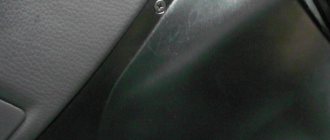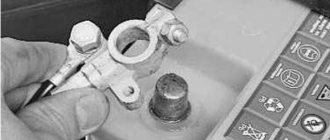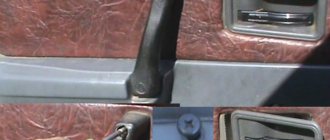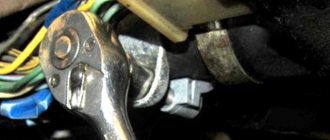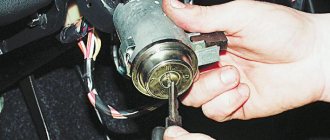Almost any motorist can repair the ignition switch. To do this, you just need to know its structure and sequence of actions. In most cars, its design is similar, and differs only in minor features. The most common problems due to which you have to repair the ignition switch yourself are failure of the cylinder, oxidation of the contacts, and destruction of the insulation on the wires. Next, we will provide you with maximum information so that you are able to carry out repair work yourself, and also provide repair algorithms using the example of popular cars in our country - VAZ 2110-2112, Honda Civic, Ford Focus 2, Opel Omega B.
Functions and design of the ignition switch
First, let's list the functions that the lock performs. These include:
- performing switching to connect/disconnect the vehicle’s electrical system to the battery;
- connecting/disconnecting the primary (low-current) circuit of the ignition system to the power source;
- short-term connection of the starter to the electrical system while starting the engine;
- ensures the functioning of energy consumers when the engine is not running (for example, radio, headlights, alarm, etc.);
- when the engine is not running, it locks the steering wheel (not on all cars).
How to remove the ignition switch? The lock design may vary slightly for different car models. Accordingly, the process of dismantling and checking it will consist of different stages. You will need a Phillips head screwdriver, a thin awl and an electrical tester. VAZ-2108 car in our country . It’s worth mentioning right away that the lock and ignition system of this model are in many ways similar to all front-wheel drive VAZs.
Dismantling the ignition switch of a VAZ 2108 occurs according to the following algorithm:
- Remove the negative terminal from the battery.
- Remove the steering shaft housing. To do this, use a screwdriver to unscrew the screws securing it. The casing will split into two parts and can be easily removed.
- Next you need to remove the front part of the lock. Also disconnect from it the plug with the power wires and the plug with the wires coming from the relay.
- Before dismantling, set the ignition key to the “0” position in the lock. This will disable the steering lock.
- Unscrew the fastening screws and remove the lock.
- Then you can use the tester to check or diagnose and troubleshoot if one is detected.
An awl may be needed during operation if it is necessary to replace the contact group. This tool prys up and removes the retaining ring that holds the lock core inside the case. The contact group can only be removed by dismantling it.
What does the ignition switch consist of?
Now you need to familiarize yourself with what parts the lock consists of and what can break in it. Please refer to the attached drawing. It shows a cross-section of the ignition switch. Numbered parts:
- Locking rod.
- Ignition switch housing.
- Roller.
- Contact disk.
- Contact sleeve.
- The block, a, is a wide protrusion of the contact part.
Now that we know what parts the ignition switch consists of and how to disassemble it, it will be easier for you to understand what malfunctions may occur in its mechanism.
What should you not forget when working?
When carrying out repairs, in order to change the contact part, a retaining ring is pryed into the end of the housing with an awl (holds the core of the ignition switch inside a convenient housing), after which the contact part can be removed. The new contact group is installed in such a way that the location of plugs 15 and 30 is where the locking rod is located. In this case, with their wide protrusion, the contacts must fit into an equally wide groove in the housing. All parts are installed on the car in the reverse order corresponding to their removal.
It is better to carry out repair work in a dry room, avoid direct contact with moisture on the contacts and terminals, so as not to disassemble this system again in the near future for banal cleaning of oxides.
According to the electrical diagram, a new or repaired ignition switch is installed, as well as all wires in accordance with the preliminary marking of the terminals. In order to simplify the connection of wires, their markings are transferred to the new system. Provided all installation and connection rules are followed, the new lock will be able to operate for a long time. In order to guarantee uninterrupted operation and avoid early breakdowns, it is necessary to choose a modern and high-quality model.
Possible faults
The ignition switch is a fairly simple device. Therefore, the malfunctions that arise are typical. Next, we will briefly list the most common ones that car owners of different cars encounter. These include:
Ignition switch assembly
- Oxidation or melting of contacts . It occurs for various reasons - moisture getting on them, an increase in voltage in the car’s electrical network, their mechanical failure due to damage or aging.
- Destruction of wire insulation or contact group . It can occur due to mechanical damage or simple aging, when the insulation dries and crumbles. As a rule, this malfunction can be determined by the failure of several electrical appliances at once that are clearly not interconnected (having different fuses and electrical circuits).
- Malfunction of the lock cylinder . Usually this is simple mechanical damage caused by aging and wear. In this case, the key in the lock can jam, slip, and so on. It may also be caused by small particles or dirt getting inside. If the larva is not very worn, then you can try to restore it, otherwise it is better to replace it.
- Wear of internal parts of the lock . This happens naturally over time. As the machine is used, the ignition switch parts gradually wear out and may become unstable or completely fail. The way out of this situation would be to completely replace the cylinder or lock (depending on what failed).
- Key wear . This doesn't happen often, but if you own an old car, the possibility still exists. The key may also become deformed or mechanically damaged. In this case, you need to either use a spare key or completely change the lock with new keys.
Now that we have dealt with the causes of the malfunctions, we can move on to the issue of eliminating them. Let us analyze in detail the process of repairing the ignition switch using the example of specific popular cars in our country.
Front left door lock with electric drive (2 contacts) on a VAZ
- Manufacturer: AvtoVAZ
- 0 reviews
- Description
- Characteristics
- Video
- Reviews 0 ? '(' + product.reviewsCount +')' : »>>
Dear customers, in order to avoid errors when sending the left driver's front door lock assembly with electric drive (5 contacts) for Lada Granta, Kalina 2, Priora 2, Datsun "NORM" and "LUX" configurations, please indicate the model of your car in the "Comment" line , “NORM” and “LUX” or “STANDARD” equipment, year of manufacture.
Car door lock 2190-6105013 front left (driver's door) is designed to close the door and prevent unauthorized access to the car Lada Granta, Kalina 2, Datsun, Priora 2 for the “NORMA” and “LUX” trim levels.
1 – rod of the lever of the external handle; 2 – rod of the lock cylinder mechanism.
The internal door lock is an important element of the vehicle's passive safety system. During a side impact, it ensures the transmission and dissipation of forces from the door to the body.
The door lock meets the requirements of comfort - it has a pleasant sound when closing and tactile sensations when opening the handles.
1- to the rear harness block; 2 — window lift motor; 3 — door lock; 4 — switch block; 5 - to the speaker in the door
The internal lock of the front right door 2190-6105013 with electric drive (5 contacts) of the Lada Granta, Kalina 2, Datsun, Priora 2 is a non-separable structure and, if necessary, can only be replaced as an assembly.
It is advisable to lubricate the moving parts of the lock with a thick lubricant, such as lithol.
When replacing a lock with a cylinder with a new one, you will also have to replace the cylinders of the remaining locks, including the ignition switch, or already have 2 keys on the keychain.
The control signal goes through the electric lock 21900-6105013-10 of the driver's door. If the driver's door electric lock fails, the other doors will be locked. Opening occurs mechanically using a key.
Other articles of the product and its analogues in catalogs: 2190-6105013-10, 219006105013-10, 21900-6105013-10.
Lada Granta, Kalina, Kalina 2, Priora 2, Datsun.
Any breakdown is not the end of the world, but a completely solvable problem!
How to independently replace the electric lock on the driver's inner door on a Grant family car.
AvtoAzbuka Internet Store, repair costs will be minimal.
Just COMPARE and BE SURE.
Don’t forget to share the information you find with your friends and acquaintances, as they may also need it - just click one of the social networking buttons below
Repair of ignition switch VAZ 2110
Video of replacing the ignition switch of front-wheel drive VAZs (VAZ 2110-2112, “Kalina”, “Priora”)
You can identify a malfunction of the “tens” ignition switch using a tester. To do this, you must first dismantle the lock. Briefly, the algorithm of actions will be as follows:
- Disconnect the negative terminal from the battery.
- Unscrew the cover around the steering column.
- Disconnect the ignition switch connector.
- Insert the key into the lock and move it sequentially to positions I and II. In this case, using an ohmmeter it is necessary to measure the resistance between the contacts (see diagram and table).
- If the ignition switch and contact group are working properly, the resistance should be 0.
Below we provide you with a table that provides information about which contacts close and open in different key positions, as well as what machine mechanisms they are responsible for.
| Key position | Which contacts are under voltage? | Closable circuits |
| Position "0" (off) | Contact 30 | None |
| Position I (ignition on) | Contacts 30-15 | Ignition system circuits, generator excitation, power supply to headlights, turn signals, control panel, windshield wipers and windshield washers, electric heater fan motor is powered, rear window heating and cigarette lighter are turned on. |
| Position II (starter running) | Contacts 30-15 and 30-50 | All the above circuits, as well as the starter, are running. |
Ignition circuit for VAZ 2110
Let's move on to practice: replacing the ignition switch cylinder
To change the cylinder, you need to purchase the corresponding mechanism of a certain article. Please note that you only need to buy original parts produced by the car manufacturer. If you buy a Chinese larva, there is a chance that it will not fit into the seat, since its size will be larger. In this case, you will have to grind the device, and this will take additional time.
The replacement procedure is performed as follows:
- First of all, turn off the ignition and open the hood. Disconnect the terminals from the battery.
- After this, using a Phillips screwdriver, you will need to remove the screws that secure the plastic steering wheel cover. By unscrewing the bolts, this cladding element can be dismantled.
- Next, you will need to disconnect the connectors connected to the contact group of the device; they are secured with bolts. In this case, you will need two screwdrivers, one longer and one shorter. The screw itself that you need to unscrew is located inside the device.
- Now you will need a wire, with its help you need to press on the cylinder mount through the existing hole, at the same time the ZZ must be moved to position 2. After this, you will be able to remove the larva by about 0.5 cm. Having done this, it can be completely dismantled.
- When installing a new cylinder, make sure that the 3Z is in position 2. Using the pin, press the fastener and install the new structural element.
If you change the cylinder in the ignition switch, then you should also change the cylinders in the trunk lock and in the doors, otherwise you will not be able to open the door and trunk with the key to start the engine.
Photo gallery “Changing the larva with your own hands”
Honda ignition switch repair
Honda ignition lock cylinder repair
Let's consider the issue of dismantling and repairing the ignition switch using the example of a Honda Civic. According to reviews from the owners of this car, many of them periodically encounter this problem (childhood disease of this model). The dismantling process is largely similar to that described above. In particular, to dismantle the lock, you must:
- Remove the front panel parts that block access to the lock. To do this, you need to unscrew the 3 bolts located at the bottom, under the steering column.
- Break off the mounting bolts. The lock itself is mounted on two bolts with shear heads. They are designed to protect your car from theft. These bolts need to be removed using a chisel and hammer. Instead, you can later use two 8 bolts.
- Disconnect the toggle switch.
Castle in parts
The lock cylinder, as in the previous version, can be replaced without completely dismantling the lock. Although it is still better to do this, since it will be more convenient for you to work. But in any case, the operation to replace and repair the larva is performed according to the following algorithm:
- The first step is to remove the cotter pin securing the cylinder in the lock body. This should be done with a thin metal object, such as an awl, knife or clock screwdriver. They hit it with a hammer, knocking it out of its seat. If you cannot get the cotter pin using this method, you can simply drill it out.
- Insert the key into the cylinder and remove the cylinder with the cylinder.
- To disconnect the cylinder and the cylinder, you need to pull out another cotter pin. To do this, again you need to use a long metal object. And then remove it with pliers.
- Next, they take out the larva and carry out the necessary repair work depending on the problems that arise.
Also, when making repairs, lubricate the cylinder. As in other cars, when installing the cylinder with the cylinder in the lock body, remove the key from it and press the steering wheel lock pin as deeply as possible.
Some car owners throw out one or more secretions from the larva during repairs. This absolutely cannot be done for several reasons . Firstly, this significantly reduces the anti-theft properties of the ignition switch. Secondly, a situation may arise when, over time, the driver removes the key from the lock in the ignition on position. And if you leave the car in this position for a long time, the battery will discharge. Because of this, you will not start the engine, and the immobilizer may also become out of sync.
Cardinal ways
When the key stub cannot be obtained by any of the gentle methods, radical measures have to be taken.
One of them is the extraction of the larvae.
In a cylinder lock it is located in a cylinder. If it is located in a protruding form, it should be clamped with a gas key and rolled up, and the lock should be opened with a flat screwdriver.
If the cylinder is concentrated in the closed position and is not visible, then first you need to remove the top cover. Then act in the same way as in the first case.
There is a method in which the larva is knocked out using a chisel and hammer.
Another option is to cut down the lock bolts with a regular hacksaw.
The most barbaric methods are to completely cut out the entire lock or remove the door from its hinges. Such measures are taken in extreme cases, when all others have proven ineffective or when it is urgently necessary to get into the apartment. This usually happens if there is a small child at home or the smell of gas or combustion comes from the apartment.
Ford Focus 2 ignition switch repair
Ford Focus2 ignition switch repair
By analogy with other cars in the Ford Focus 2, to repair the ignition switch, you first need to dismantle it. This operation is carried out in the following sequence:
- Disconnect the negative terminal from the battery.
- Remove the steering column cover by first unscrewing the two mounting bolts at the bottom (under the steering column).
- Using a screwdriver, press the lock of the immobilizer antenna unit and move it to the side without disconnecting the wire from it.
- Insert the key into the lock in position I.
- Insert the pin into the hole located in the lower part of the lock body, and then press the latch.
- The lock cylinder mount will be released and you can easily remove it from its seat.
Further repair work depends on the problems encountered. It is necessary to wash all the elements of the lock and lubricate them. On the opposite side of the lock there is a contact group. It is advisable to remove it and check the state of wear. It is secured with two latches. Check the condition of the brushes and replace worn ones if necessary. In any case, it is necessary to clean the dirt from it. Take everything apart very carefully, there are a lot of small parts and springs inside. Assembling the mechanism and installing it in place occurs in the reverse order.
Cylinder lock type
Another important point. There are two types of cylinders in locks:
- with a turntable - that is, there is no keyhole on the inside of the door, only a turning mechanism for closing the lock
- without spinner - with keyholes on both sides.
Repair of the ignition switch "Opel Omega B"
Let us conditionally divide the stages of breakdown of the ignition switch of an Opel Omega B car into three stages according to their complexity and neglect. So:
- Periodic jamming of the key in the lock . The easiest way at this stage is to remove the lock, wash and lubricate it. The easiest repair option is to spray WD-40 into the well and twist the wrench in it.
- Does not restart . As a rule, this problem manifests itself in a situation when the car starts and drives normally, and you can stop the engine with the key. However, when turned on again, the motor does not start. To do this, you need to remove and reinsert the key. Here you definitely need to disassemble the lock and carry out diagnostics and repairs.
- The key doesn't turn . It is better not to reach this stage. After all, in this case the steering wheel will inevitably lock, which can lead to troubles on the roads.
Installation of the larva
You can change the larva yourself. To do this, it is enough to have the minimum skills of a home handyman.
Before replacing the locking mechanism cylinder, you need to make sure that it matches the lock in size, diameter, and cylinder shape. We insert the key into the hole and fix it in the closed position. Then we install the core in place of the previous one and secure it with a screw. The core should fit neatly into its nest. The fasteners can be located symmetrically or asymmetrically relative to the end of the door, depending on the lock model.
Normal lock replacement
The simplest procedure is if the mechanism is working properly:
- Remove any external parts that block the lock.
- Insert the key.
- Twist and push/pull.
In a car door
To change the cylinder or clean and lubricate it more thoroughly, you will have to be patient and careful:
- Remove the handle from the interior side.
- Remove the casing.
- Disconnect the rod leading to the locking element at the bottom of the door.
- Remove the bracket that holds the mechanism (in Lada), unscrew the screw that performs the same function.
- Push out or pull out the larva from the outside.
Ignition lock cylinder
Here you will need to disassemble the entire structure that attaches the ignition unit to the steering column or get under the dashboard. At the same time, shear screws pose a great challenge: they are not reused, and in some cases it is difficult to find their exact analogues.
Important: Miss Clean Magazine strongly recommends disassembling the lock by following the vehicle manual exactly.
When the entire mechanism is disassembled, all that remains is to turn the key and pull out the cylinder.
Reviews about us
Hello!
Yesterday I used the service of making a set of chip keys for my Volvo XC90 from your company. I will say to the point - the craftsmen did everything very quickly, efficiently and inexpensively. Well done! Thank you for the European level of service! Artem Nagorny 04/16/14 I would like to thank the employees of your company for their work. I was convinced of their professionalism from my own experience. I ordered chip keys (I have a Suzuki MR Wagon) and was really surprised how quickly they did everything. I recommend this company to everyone. Bogdan Perezyabov 05/17/14
Thanks to the masters from Key2012! I personally was very pleased with your work, which is why I decided to write a review. The guys do a good job, they quickly made me chip keys for the Fiat Panda. I liked everything, especially the normal price. I wish you good luck in developing your company! Anatoly Gurev 07/01/14
If you want to make an order? Check the cost? Contact us by phone number 8, or leave a request on the website!
If the key won't turn
In the case of the ignition switch, everything comes down to the same scheme: disassemble the lock as much as possible. Then you need to knock out the stopper pin and remove the mechanism. In extreme cases, you will have to drill it and then knock it out.
Tricky trick
Most often, the key in the ignition switch stops turning for three reasons:
- grease abrasion;
- clogging with dust (solved by washing with WD-40 or other car cleaners);
- metal fatigue.
For reference, a cylinder lock is based on a series of pins (pins), consisting of two halves and running up and down on springs. To open the lock, you need to place all the pins at a given height, that is, so that they fit exactly into the recesses of the original key.
Over time, the springs weaken and stop lifting the pin. Such a “tired” element can simply be removed from the lock - the car will start again, and with the original key, so there is no need to change all the locks in the car. If more than one pin is broken, then dismantling is only a temporary measure, because such a car will start with any third-party key.
Door locks
Very often the key does not turn in the car door because it is rusty (it was rarely used) or frozen. The first can be solved with a rust converter (it will take quite a lot of time), the second can be solved by heating.
What is a lock cylinder
The cylinder is the part of the lock with a secret mechanism into which the key is inserted. The cylinder is also called the cylinder mechanism or core. Inside, it consists of a set of pins that can be opened with a specific set of keys. The wrong key will not be able to open the lock because its grooves and grooves are not suitable for lining up the pins in a certain combination. The main role of the pith is to manage constipation.
Modern doors are equipped with locks with two types of locking cylinders: key-turner and key-key. The first option is more expensive, but is convenient and safe in further use since the door is locked and opened from the inside without using a key. A door locked from the inside with a turntable will not be opened from the outside with a key, which allows you to protect yourself from the possibility of thieves getting inside. Leaving the key in the hole prevents the door from being accidentally locked from the inside, which is important for families whose members include children and the elderly.
In addition, the larvae are divided into three types according to their level of resistance to burglary:
- Short. The pins of such larvae contain up to 10 thousand combinations, which is very small, so it is easier to find a third-party key for such a lock. The pins are made of soft, easily worn brass. Chinese-made entrance doors are often equipped with low-security cylinder mechanisms;
- Average. The number of pin combinations reaches 50 thousand, which makes it impossible to open the lock with a similar key. The material for making the pins is not strong enough;
- High. The number of pin combinations is more than 100 thousand, which guarantees high security and long service life of the lock. Reliable high-quality materials (brass for the body, hardened or magnetic pins), increased assembly accuracy. Typically, the manufacturer produces locks equipped with such cylinders with protection against knocking out and drilling.
Door manufacturers equip modern products with an armored lining on the lock, which protects against drilling. To replace the core, such a lock will have to be completely disassembled, which requires special knowledge and skills, without which you will have to call a specialist.
How to remove the cylinder without a key
If there is no key to the ignition switch, the procedure is exactly the same as if there was a key, but did not turn. On entrance doors, it is most often not possible to remove the trim and disassemble the lock. Therefore, if there is no key, the lock is opened or broken.
Master key
This method will require at least 10 minutes of time and two wires: straight and curved at the end.
- Run both wires into the hole.
- Bently tap the pins until they reach the desired position.
- Constantly try to turn the cylinder with a straight wire.
Bumping key
It replaces the original key, but is ineffective in the problem being solved with the larva. The essence of its action: the bumper is inserted into the well, the head is hit with a hammer, the pins bounce off from a sharp push and, returning to their original position, pass the point when the cylinder is released - you need to have time to turn it. In the case of replacing the cylinder, you will have to simultaneously turn and push out, and all this until the pins block the lock again.
Drilling
If you need to leave the house urgently, the most effective and fastest method is to take a drill slightly wider than the hole and make a hole in the lock. The stopper and the bolt will separate from each other, and the cylinder will easily be squeezed out. The same technique works on car doors. But the ignition switch cannot be “repaired” this way.
Knockout
This is one of the least effective methods. Procedure:
- Take a chisel, slightly wider than the hole, but not wider than the larva.
- Place it on the cylinder and hit the butt with a hammer until the lock comes out.
Breaking out
The essence of the method is to grab the cylinder with a special, gas or other key (all façade elements must first be removed) and turn it. The lock will be broken, but the door will open.
It may be enough to lubricate a jammed lock, but if the reason is metal wear or the key was lost, you will have to disassemble the structure to get to the stopper, or select an analogue that will open the lock without damaging it.
The cylinder is broken: how to open the door. Methods and tips
If the lock did not receive timely repairs and failed you, leaving you in front of a locked door, there are several ways out of the unpleasant situation.
- Try to get into the house through the window. Not suitable for apartments located in high-rise buildings.
- Dismantle the entire structure, including the frame. To do this, you need to remove the linings and frozen pieces of polyurethane foam around the entire perimeter of the opening and saw through the places connected by welding using a grinder. To apply this method, you need to have the appropriate tool at hand.
- You can also use a grinder, but only for cutting out the lock. This is quick, but in the future it requires replacing the entire entrance structure.
- Call the rescue service or the company that installed the door. It will take time to call and work with specialists, and sometimes you may need documentation confirming your ownership of the house.
There are ways that allow you to open a broken lock with the least loss:
- Using a pin, paper clip or wire. Break the improvised master key into 2 parts. Insert one into the lock and try to turn it, while simultaneously moving the pins away with the other part. Does not work with all types of mechanisms.
- A screwdriver. Effective for cross lock. After unscrewing the top, drill a hole above the keyhole, insert a screwdriver and turn it.
- Drilling out the lock cylinder. Not suitable for those structures that are equipped with powerful armor protection linings.
